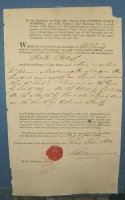
Piet Retief's original land
title

Following a successful campaign against the Xhosa more land became available in the Eastern Cape.However Pieter Retief, later to lead the Voortrekkers on their great trek northwards, had already experienced the incursions of the Xhosa and had concerns about the lack of protection the British Government gave Dutch farmer in the newly captured land. He asked for and was granted an unallocated piece of land in the town of Grahamstown and became a dairy farmer and general merchant. This land grand is signed by General Lord Charles Somerset in favour of the future Leader of the Voortrekkers, Pieter Retief, and has Lord Somerset's red wax seal next to his signature.
The land title issued to Pieter Retief and seen right is part of the Balson Holdings Family Trust Collection
The land grant is signed 15 June 1823 in Grahamstown in the district of Albany.
The historical events in 19th century South Africa are marked by the "Groot Trek". Starting in 1835, more than 10,000 Boers, the Voortrekkers, left the Cape Colony with their families and went north and north-east. The reasons for this mass exodus were their economic problems, the threatening danger of conflict with the Xhosa, who settled on the other side of the Fish River, and primarily, discontent with the English colonial authorities who didn't provide sufficient protection and had forbidden the slave trade and postulated the equality of whites and non-whites.
In the border area at the Fish River constant conflicts with the Xhosa occurred and the central government in Cape Town was neither willing nor able to give the Boers efficient military protection. Absolutely incomprehensible to the conservative Boer communities was the approach of the British colonial government towards the black inhabitants of the colony, who were held as slaves on most of the white farms. From 1833 on the slave trade was declared illegal and the "Emancipation Act" demanded that white masters set their slaves free, against payment of a small compensation by the state. The Voortrekkers felt that the British policy destroyed their traditional social order which was based on racial separation, and would undermine white predominance, which they saw as God's own will
The Voortrekkers, now worn out through the death of their second leader Gert Maritz, and through internal quarrels, were at the end of their power. Only their newly elected leader Andries Pretorius was successful in consolidating the group and preparing it for a retaliatory strike against the Zulu king. On December 16, 1838 the Zulus were completely defeated in the famous "Battle of Blood River". This enabled the founding of the first short-lived Boer Republic in Natal, with Pietermaritzburg as its capital. By 1842, British troops occupied Port Natal, today's Durban, and annexed the hinterland as a Crown Colony. The Voortrekkers retreated behind the Drakensberg.
The Great Trek was organized in resistance to the politics of the Cape government. In 1835, the first groups set out. Under the leadership of Louis Trichardt and Hans van Rensburg, they opened up the north of today's Mpumalanga. Other groups, under the command of Andries Pretorius, Gert Maritz and Piet Retief followed. In the area around ThabaNchu in what would become the Orange Free State, a huge Boer camp of 5,000 Voortrekkers eventually gathered.
They headed for Natal to gain land for settling and grazing. To that end they had to negotiate with Dingane, the king of the Zulus. The negotiations ended with the agreement that large areas in central and south Natal would be ceased to the Boers. However, when the delegates under Piet Retief prepared to leave, they were lured by the Zulus into an ambush and killed. Then the Zulu warriors fell upon the Voortrekkers who had made camp at the foot of the Drakensberg to wait for the return of their leaders. The Zulus killed 500 of them and stole almost all their cattle.
A graphic video of the murder of Piet Retief and his men can be seen at this link: